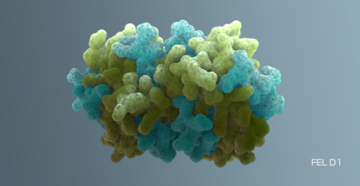真実と誤解


猫アレルギーについては、数多くの俗説や誤解が存在し、猫アレルギーを患う方々の多くは、猫アレルギーが実際に何を原因としているかを完全には理解していません。
猫アレルギーに関する俗説を一掃する科学的な事実をご紹介します。
猫アレルゲンについての事実

猫アレルギーの原因は猫の毛ではありません
俗説に反して、アレルギー反応を誘発するのは猫の毛ではありません。猫の唾液腺と皮脂腺(皮膚)で産生されたアレルゲンが、猫アレルギーのある人にアレルギー反応を誘発させる原因です…

アレルゲンフリー、または「ハイポアレジェニック(低アレルゲン)」である猫はいません
猫の品種によっては - 特に毛のない品種 -「ハイポアレジェニック」であるという俗説があります。「ハイポアレジェニック」は、正確には「アレルゲンが少ない」という意味ですが、多くの人が「アレルゲンフリー」という意味に誤解しています…

毛色はアレルゲンの産生に影響を与えません
猫の毛色が黒っぽく毛が長いほど、毛色が明るく毛が短い猫よりも、アレルギー反応を誘発しやすいという俗説があります。しかし、毛色と毛の長さは影響を与えません…

アレルゲンの産生に関係する身体的特徴は性別だけ
毛の長さと毛色は、Fel d 1の産生には影響を与えないことが実証されていますが、唯一相関関係があるとみられているい身体的要因が存在し、それは性別です…


ピュリナ インスティテュートは、真実の啓発と誤解を正すために科学的な事実を提供します。詳しくは下記をご覧ください。
Fel d 1と猫アレルギーに関するQ&A
関連コンテンツ
出典元
- Butt, A., Rashid, D., & Lockey, R. (2012). Do hypoallergenic cats and dogs exist? Annals of Allergy Asthma and Immunology, 108(2), 74-76. doi: 10.1016/j.anai.2011.12.005
- Nicholas, C., Wegienka, G., & Havstad, S. (2008). Influence of cat characteristics on Fel d 1 levels in homes. Annals of Allergy Asthma and Immunology, 101(1), 47-50. doi: 10.1016/S1081-1206(10)60834-4
- Kelly, S.M., Karsh, J., Marcelo, J., Boeckh, D., Stepner, N., Litt, D.,...Yang, W.H. (2018). Fel d 1 and Fel d4 levels in cat fur, saliva and urine. Journal of Allergy and Clinical Immunology, 142, 1990-1992.e3. doi: 10.1016/j.jaci.2018.07.033
- Bastien, B.C., Gardner, C., Satyaraj, E. (2019). Wide range of yearly salivary Fel d 1 in domestic shorthair cats. Accepted, Journal of Feline Medicine and Surgery.
- Platts-Mills, T.A.E., Vervioet, D., Thomas, W.R., Aalberse, R.C., & Chapman, M.D. (1997). Indoor allergens and asthma: Report of the Third International Workshop. Journal of Allergy and Clinical Immunology, 100, S1-S24.
- Dabrowski, A., Van der Brempt, X., Soler, M., Seguret, N., Lucciani, P., Charpin, D., & Vervloet, D. (1990). Cat skin as an important source of Fel d 1 allergen. Journal of Allergy and Clinical Immunology, 86, 462-465.
- Bartholome, K., Kissler, W., Baer, H., Kopietz-Schulte E., & Wahn, U. (1985). Where does cat allergen 1 come from? Journal of Allergy and Clinical Immunology, 76, 503-506. doi: 10.1016/0091-6749(85)90734-1
- Morgenstern, J.P., Griffith, I.J., Brauer, A.W., Rogers, B.L., Bond, J.F., Chapman, M.D., & Kuo, M.C. (1991). Amino acid sequence of Fel dI, the major allergen of the domestic cat: Protein sequence analysis and cDNA cloning. Proceedings of the National Academy of Sciences, 88(21), 9690-9694.
- Bonnet, B., Messaoudi, K., Jacomet, F., Michaud, E., Fauquert, J.L., Caillaud, D., & Evrard, B. (2018). An update on molecular cat allergens: Fel d 1 and what else? Chapter 1: Fel d 1, the major cat allergen. Allergy Asthma & Clinical Immunology, 14. doi: 10.1186/s13223-018-0239-8
- Dávila, I., Dominguez-Ortega, J., Navarro-Pulido, A., Alonso, A., Antolin-Amerigo, D., Gonzalez-Mancebo, E.,…Torrecillas, M. (2018). Consensus document on dog and cat allergy. Allergy, 73, 1206-1222. doi: 10.1111/all.13391
- Salo, P.M., Cohn, R.D., & Zeldin, D.C. (2018). Bedroom allergen exposure beyond house dust mites. Current Allergy and Asthma Reports, 18, 52-68. doi: 10.1007/s11882-018-0805-7
- Zielonka, T., Charpin, D., Berbis, P., Luciani, P., Cassanova, D., & Vervloet, D. (1994). Effects of castration and testosterone on Fel d 1 production by sebaceous glands of male cats: I. Immunological assessment. Clinical and Experimental Allergy, 24(12), 1169-1173.
- Ramadour, M., Birbnaum, J., Magalon, C., Lanteaume, A., Charpin, D., & Vervloet, D. (1998). Cat sex differences in major allergen production (Fel d 1). Journal of Allergy and Clinical Immunology. 10(2-1), 282-284.
- Jalil-Colome, J., de Andrade, A.D., Birnbaum, J., Casanova, D., Mége, J.L., Lanteaume, A., Charpin, D., & Vervloet, D. (1996). Sex difference in Fel d 1 allergen production. Journal of Allergy and Clinical Immunology, 98(1), 165-168.
- Durairaj, R., Pageat, P., & Bienboire-Frosini, C. (2018). Another cat and mouse game: deciphering the evolution of the SCGB superfamily and exploring the molecular singularity of major cat allergen Fel d 1 and mouse ABP using computational approaches. PLoS ONE, 13(5), e0197618; doi: 10.1371/journal.pone.0197618
- Zahradnik, E., & Raulf, M. (2017). Respiratory allergens from furred mammals: Environmental and occupational exposure. Veterinary Sciences, 4(3), 38. doi: 10.3390/vetsci4030038.
- Morris, D. (2010). Human allergy to environmental pet danders: A public health perspective. Veterinary Dermatology, 21(5), 441-449. doi:10.1111/j.1365-3164.2010.00882.x
- van Ree, R., van Leeuwen, W., Bulder, I., Bond, J., & Aalberse, R. (1999). Purified natural and recombinant Fel d 1 and cat albumin in vitro diagnostics for cat allergy. Journal of Allergy and Clinical Immunology, 104(6), 1223-1230.
- Black, K.R., Murphy, B., Filep, S., Brook, J., Subbarao, P., Turvey, S., … Chapman, M.D. (2018). Comparison of Fel d 1 and Fel d4 levels in house dust samples from the Canadian CHILD birth cohort. Journal of Allergy and Clinical Immunology, 141(2), AB7.
- Svanes, C., Zock, J.P., Anto, J., Dharmage, S., Norback, D., Wjst, M., … Early Life Working Group of the European Community Respiratory Health Survey. (2006). Do asthma and allergy influence subsequent pet keeping? An analysis of childhood and adulthood. Journal of Allergy and Clinical Immunology, 118(3), 691-698. doi: 10.1016/j.jaci.2006.06.017
- Bousquet, P.J., Chinn, S., Janson, C., Kogevinas, M., Burney, P., & Jarvis, D. (2007) European Community Respiratory Health Survey I. Geographical variation in the prevalence of positive skin tests to environmental aeroallergens in the European Community Respiratory Health Survey I. Allergy, 62(3), 301-309.
- Chan, S.K., & Leung, D.Y.M. (2018). Dog and cat allergies: Current state of diagnostic approaches and challenges. Allergy, Asthma and Immunology Research, 10, 97-105. doi: 10.4168/aair.2018.10.2.97
- Björnsdottir, U. S., Jakobinudottir, S., Runarsdottir, V. & Juliusson S. (2003). The effect of reducing levels of cat allergen (Fel d 1) on clinical symptoms in patients with cat allergy. Annals of Allergy, Asthma and Immunology, 91, 189-194.



